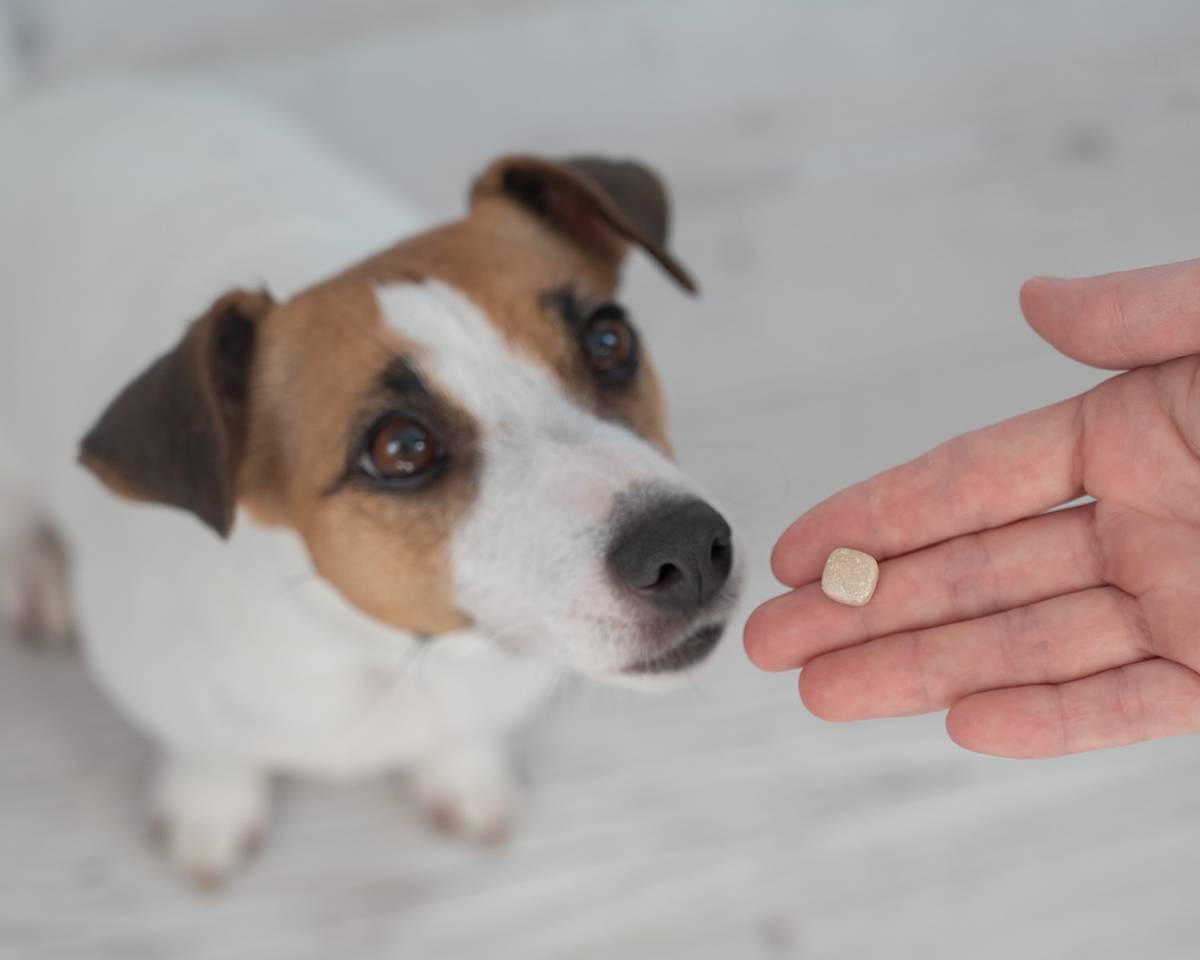Can You Give Your Dog Antihistamines?
You might just make it worse

Share Article
In this article:
Dog friendly antihistamines When to give antihistamines Allergic reaction signs Antihistamine dosage What to do if your dog overdoses Antihistamine alternatives FAQs
Dogs are inquisitive creatures and, often through every adorable fault of their own, find themselves face-to-face with something that may trigger an allergic reaction, such as a bee or a spider. Does the answer to their reaction lie in your human medicine cupboard? Read on to find out whether antihistamines can and should be given to dogs.
Can dogs take antihistamines?
Yes, dogs can take certain antihistamines, but its not always straightforward. Whilst certain types can help with mild allergies, they are usually less effective in dogs than in humans and can cause side effects such as drowsiness or hyperactivity.
It is important to remember that over-the-counter antihistamines are made for humans. Some contain ingredients that are toxic to dogs such as certain decongestants or pain relief pills. That’s why you should always speak to your vet before giving your pet any medication meant for people.
Antihistamines that are safe for dogs
There are no antihistamines licensed specifically for dogs in the UK, so vets often prescribe human versions instead. These aren’t tested as thoroughly for use in animals, so dosing guidance and side effects are less clear. It is therefore a very bad idea to make any decisions about antihistamines for your dog without involving your vet.
Common antihistamines that may be prescribed for dogs include:
Cetirizine (eg, Piriteze)
Chlorphenamine (eg, Piriton)
Diphenhydramine (eg, Benadryl)
Loratadine (eg, Clarityn)
However, the right drug and dose will depend on your dogs size, age and health. Some dogs may need a lower dose or should avoid certain medications altogether, so do have a chat with your vet first.
When to give your dog an antihistamine
Antihistamines work by blocking the effects of histamine, a chemical which is released during an allergic reaction. Your dog may have a sudden onset allergic reaction to a specific trigger, such as a wasp sting or a spider bite, or they may have a more chronic reaction to an allergen that is present in their environment, such as dust, pollen or a food ingredient. Antihistamines may help with some symptoms, especially in mild cases, but they won’t always be the most effective option.
Signs your dog is having an allergic reaction
If your dog is having an acute allergic reaction they may develop a swollen muzzle, which in severe cases can obstruct their airways and cause difficulty breathing. They may also develop small bumps all over their skin, known as hives, and be generally very itchy and irritated.
For more long-term allergies, dogs will tend to have reddened, inflamed skin, which is very itchy. They are likely to have brown staining of their toes from licking, and you will catch them frequently gnawing at themselves. Sometimes this will lead to bald patches. They may also have recurrent ear infections, anal gland issues or red, swollen eyes.
How much antihistamine should you give a dog?
The amount of antihistamine depends on the type of drug you are giving, the size of your pet and the severity or cause of the allergy. Never guess the dose or copy the human instructions on the box. Be aware, many antihistamines contain extra ingredients such as decongestants, which can be toxic to dogs. It is essential to ensure that the drug you are using contains no other active ingredients or harmful chemicals. Your vet is best placed to advise you on this.
What to do if your dog overdoses on antihistamines
If you do choose give your dog antihistamines and begin to notice adverse reactions, seek advice from your vet. Alternatively, contact the animal poison lineopens in new tab, who will be able to advise you on exactly what action is required for the specific amount of drug your pet has ingested.
Alternatives to antihistamines for dogs
Instead of using antihistamines you can try to avoid or reduce the number of allergens your dog is exposed to by keeping them indoors when the pollen count is high and by reducing dust in your home. The most common food allergens include chicken, pork and beef protein, so switching diet to avoid these can help. This is best discussed with your vet to find out which allergen is causing the most issues for your pet.
Dog friendly skin wipes and shampoos can also be used to reduce the number of allergens on the skin and to settle inflammation.
Natural alternatives to medications include turmeric, liquorice and omega 3 fatty acids, which have some evidence supporting their use and are unlikely to do any harm. Acupuncture has also been shown to be more effective than antihistamines in certain individuals.
There are many alternative prescription medications that are often more effective at controlling allergies than antihistamines. Steroids such as prednisolone reduce inflammation and ciclosporins modulate the immune response, however they both have a number of side effects. There are several other options available so it is advised to speak to your vet to find out what might work best for your pet.
Final thoughts: can you give antihistamines to your dog?
In short yes, but not without speaking to your vet first. Antihistamines can be helpful for controlling mild allergies but are often less effective in dogs than humans. Always check with your vet before giving any medication to your dog, even one that seems harmless.
Antihistamines and dogs: frequently asked questions
Can puppies take antihistamines?
Puppies are more sensitive to medications so extra care is needed. Always speak to your vet before giving any antihistamine to a puppy.
Can you combine antihistamines with other medications?
Not without vet approval. Mixing medications can cause drug reactions and unwanted side effects, so it’s best to avoid unless your vet says it’s ok.
Can dogs have Benadryl?
Sometimes. Benadryl contains diphenhydramine, which is occasionally used in dogs. Many preparations of Benadryl contain other drugs or chemicals that can be harmful to dogs, so it is important to check with your vet before giving it to your pet.
Can antihistamines for dogs be used to prevent motion sickness in cars?
Some can, such as diphenhydramine, but they’re not always the best option. There are better prescription medications for motion sickness so speak to your vet about which is safest and most effective for your pet.
Can I give my dog human cetirizine?
Cetirizine can be used in dogs, but because it is a human medication it can cause unexpected effects in dogs. Some dogs tolerate it fine, others do not. Your vet can help you choose the best option for your pet.
Resources
Micháľová, Alena, et al. “Comparative Study of Classical and Alternative Therapy in Dogs with Allergiesopens in new tab.” Animals, vol. 12, no. 14, July 2022, p. 1832, https://doi.org/10.3390/ani12141832. Accessed 16 Jan. 2023.
Hodson, T., et al. “Washing the Dog Reduces Dog Allergen Levels, but the Dog Needs to Be Washed Twice a Weekopens in new tab.” The Journal of Allergy and Clinical Immunology, vol. 103, no. 4, Apr. 1999, pp. 581–85.
Witzel-Rollins, Angela, et al. “Non-Controlled, Open-Label Clinical Trial to Assess the Effectiveness of a Dietetic Food on Pruritus and Dermatologic Scoring in Atopic Dogsopens in new tab.” BMC Veterinary Research, vol. 15, no. 1, June 2019.
DeBoer, D. J., and C. E. Griffin. “The ACVD Task Force on Canine Atopic Dermatitis (XXI): Antihistamine Pharmacotherapy.opens in new tab” Veterinary Immunology and Immunopathology, vol. 81, no. 3-4, Sept. 2001, pp. 323–29.
Paul Pion, D. V. M., and Gina Spadafori. “Chlorpheniramine Maleate (Chlor-Trimeton) - Veterinary Partner - VINopens in new tab.” VIN.com, Aug. 2017.
Hammond, Hayleigh. “🐝 ☀️Antihistaminesopens in new tab ☀️🐝» Animal PoisonLine.” Animal PoisonLine, 23 Nov. 2022. Accessed 6 May 2025.
Jeong, A-Young., et al. “Effects of Loratadine, Cetirizine, and Terfenadine on Histamine-Induced Wheal and Erythema Responses in Normal Canine Skinopens in new tab.” Journal of Veterinary Clinics, vol. 19, no. 2, June 2002, pp. 186–90.
Khan, Safdar A. “Cold and Cough Medications (Toxicity)opens in new tab.” MSD Veterinary Manual, 6 Aug. 2014.
Cook, Christopher P., et al. “Treatment of Canine Atopic Dermatitis with Cetirizine, a Second Generation Antihistamine: A Single-Blinded, Placebo-Controlled Study.opens in new tab” The Canadian Veterinary Journal, vol. 45, no. 5, May 2004.

Dr Nina Blackmore, MRCVS, BVSc, PgCertSAECC
Nina Blackmore is a vet who, after leaving the Royal Army Veterinary Corps, took up two very different lives. For four long, chaotic days each fortnight she lives in a tiny house next to a small animal veterinary hospital in Boston, managing hospitalised patients and treating any emergency cases that turn up. As well as emergencies she also has a keen interest in pain management and acupuncture. The rest of her time is spent in a quirky bungalow in Rutland where she and her husband run a self sufficient small holding and a dog home boarding business. She spends her life surrounded by animals and has made it her life goal to help as many as possible.
Related articles
![Black puppy itches behind her ear due to flea allergy]()
Shoo, Flea: What to Do About Your Dog’s Flea Allergy
Before you say “ew David” Moira Rose-style, learn these steps to prevent and remove fleas
![Cute weimaraner dog lying on lawn and scratching its back]()
5 of the Best Ways to Solve Your Dog’s Allergies
Here’s what works (and what doesn’t)
![an illustration of a cat inside a snowglobe]()
What Happens When the Love of Your Life Is Allergic to the Other Love of Your Life?
You don’t have to choose between your SO and your dog or cat – but here’s what may need to happen
![Brown terrier dog scratching its ear outdoors]()
Relief for Your Dog: Discover Effective Solutions for Their Seasonal Allergies
A vet explains why environmental allergies flare up and what to do about it
![dog sneezing among flowers]()
Does My Pet Have Hay Fever?
Seasonal allergies can happen to your pet, too. They might just look a little different to yours
![A dog scratching itself among the leaves outside.]()
Immunotherapy Could Be the Solution For Your Dog’s Allergies
If allergens were to ask, “am I the problem” the answer would be yes
![Woman holding a beagle in warm dappled summer light]()
You’ve Got a Summer-Lovin’ Pup. Here’s How to Keep Them Safe
Some like it hot (but not most dogs). Here are the season’s health hazards, from fleas to grass seeds







